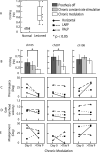Chronic stimulation of the semicircular canals using a multichannel vestibular prosthesis: effects on locomotion and angular vestibulo-ocular reflex in chinchillas
- PMID: 22255099
- PMCID: PMC3307049
- DOI: 10.1109/IEMBS.2011.6090584
Chronic stimulation of the semicircular canals using a multichannel vestibular prosthesis: effects on locomotion and angular vestibulo-ocular reflex in chinchillas
Abstract
Bilateral loss of vestibular sensation causes difficulty maintaining stable vision, posture and gait. An implantable prosthesis that partly restores vestibular sensation could significantly improve quality of life for individuals disabled by this disorder. We have developed a head-mounted multichannel vestibular prosthesis (MVP) that restores sufficient semicircular canal function to recreate a 3D angular vestibulo-ocular reflex (aVOR). In this study, we evaluated effects of chronic MVP stimulation on locomotion in chinchillas. Two of three animals examined exhibited significant improvements in both locomotion and aVOR.
Figures



Similar articles
-
Restoring the 3D vestibulo-ocular reflex via electrical stimulation: the Johns Hopkins multichannel vestibular prosthesis project.Annu Int Conf IEEE Eng Med Biol Soc. 2011;2011:3142-5. doi: 10.1109/IEMBS.2011.6090857. Annu Int Conf IEEE Eng Med Biol Soc. 2011. PMID: 22255006 Free PMC article.
-
A multichannel semicircular canal neural prosthesis using electrical stimulation to restore 3-d vestibular sensation.IEEE Trans Biomed Eng. 2007 Jun;54(6 Pt 1):1016-30. doi: 10.1109/TBME.2007.894629. IEEE Trans Biomed Eng. 2007. PMID: 17554821 Free PMC article.
-
Cross-axis adaptation improves 3D vestibulo-ocular reflex alignment during chronic stimulation via a head-mounted multichannel vestibular prosthesis.Exp Brain Res. 2011 May;210(3-4):595-606. doi: 10.1007/s00221-011-2591-5. Epub 2011 Mar 4. Exp Brain Res. 2011. PMID: 21374081 Free PMC article.
-
Current and future management of bilateral loss of vestibular sensation - an update on the Johns Hopkins Multichannel Vestibular Prosthesis Project.Cochlear Implants Int. 2010 Sep;11 Suppl 2(Suppl 2):2-11. doi: 10.1179/146701010X12726366068454. Cochlear Implants Int. 2010. PMID: 21756683 Free PMC article. Review.
-
Spatial orientation of the angular vestibulo-ocular reflex.J Vestib Res. 1999;9(3):163-72. J Vestib Res. 1999. PMID: 10436469 Review.
Cited by
-
Postural responses to electrical stimulation of the vestibular end organs in human subjects.Exp Brain Res. 2013 Aug;229(2):181-95. doi: 10.1007/s00221-013-3604-3. Epub 2013 Jun 15. Exp Brain Res. 2013. PMID: 23771587
-
Development of a multichannel vestibular prosthesis prototype by modification of a commercially available cochlear implant.IEEE Trans Neural Syst Rehabil Eng. 2013 Sep;21(5):830-9. doi: 10.1109/TNSRE.2013.2259261. Epub 2013 May 1. IEEE Trans Neural Syst Rehabil Eng. 2013. PMID: 23649285 Free PMC article.
-
Multichannel vestibular prosthesis employing modulation of pulse rate and current with alignment precompensation elicits improved VOR performance in monkeys.J Assoc Res Otolaryngol. 2013 Apr;14(2):233-48. doi: 10.1007/s10162-013-0370-7. Epub 2013 Jan 26. J Assoc Res Otolaryngol. 2013. PMID: 23355001 Free PMC article.
-
The Dynamics of Prosthetically Elicited Vestibulo-Ocular Reflex Function Across Frequency and Context in the Rhesus Monkey.Front Neurosci. 2018 May 15;12:88. doi: 10.3389/fnins.2018.00088. eCollection 2018. Front Neurosci. 2018. PMID: 29867306 Free PMC article.
-
Longitudinal performance of an implantable vestibular prosthesis.Hear Res. 2015 Apr;322:200-11. doi: 10.1016/j.heares.2014.09.003. Epub 2014 Sep 22. Hear Res. 2015. PMID: 25245586 Free PMC article.
References
-
- Leigh RJ, Zee DS. The Neurology of Eye Movements. Oxford University Press; 1999.
-
- Gong W, Merfeld DM. Prototype neural semicircular canal prosthesis using patterned electrical stimulation. Ann Biomed Eng. 2000 May;28(5):572–81. - PubMed
-
- Gong W, Merfeld DM. System design and performance of a unilateral horizontal semicircular canal prosthesis. IEEE Trans Biomed Eng. 2002 Feb;49(2):175–81. - PubMed
Publication types
MeSH terms
Grants and funding
LinkOut - more resources
Full Text Sources
Miscellaneous
